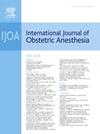Closed-loop vasopressor systems for hemodynamic stability during cesarean delivery and maternal and neonatal outcomes: a systematic review and meta-analysis
IF 2.3
3区 医学
Q2 ANESTHESIOLOGY
引用次数: 0
Abstract
Background
Closed-loop vasopressor systems automate vasopressor administration using real-time hemodynamic biofeedback; clinical equipoise exists between closed-loop vasopressor systems and manual vasopressor titration. This review evaluates the performance and hemodynamic outcomes of closed-loop vasopressor systems vs. manual titration in cesarean delivery under spinal anesthesia.
Methods
Included studies compared closed-loop vasopressor systems with manual vasopressor administration for spinal hypotension in cesarean delivery. Primary outcomes were closed-loop vasopressor systems performance and hemodynamic measures. Performance was assessed with median performance error, median absolute performance error, wobble (intraindividual variation in performance error) and divergence (performance error over time). Meta-analyses were conducted for RCTs and observational studies separately. Risk of bias was assessed using Cochrane methodology. Data were reported as risk ratio (RR) or mean difference (MD) with 95 % confidence intervals (CI).
Results
Seven studies (n = 864) were included. In three RCTs (n = 654), wobble (MD −0.66 %; 95 % CI −1.29 to −0.02; P = 0.04), hypotension incidence (RR 0.67; 95 % CI 0.55 to 0.82; P < 0.01), and the highest and lowest systolic blood pressures values (MD −4.05 mmHg; 95 % CI −7.03 to −1.06; P < 0.01 and MD 5.39 mmHg; 95 % CI 2.17 to 8.60; P < 0.01, respectively) were minimized with closed-loop vasopressor systems, but no significant differences were observed in other primary outcomes. Maternal nausea was reduced with closed-loop vasopressor systems (RR 0.47; 95 % CI 0.26 to 0.85; P = 0.01; moderate quality of evidence). In four observational studies (n = 210), the pooled values for median absolute performance error, wobble, divergence of the system, hypotension incidence, highest and lowest systolic blood pressures, highest and lowest heart rates, total fluids, total phenylephrine and ephedrine dosages were statistically significant. Risk of bias was low to moderate for all studies.
Conclusion
Closed-loop vasopressor systems may improve systolic blood pressure fluctuations in cesarean deliveries with spinal anesthesia compared to manually adjusted vasopressor dosing; however, more high-quality evidence is needed.
闭环血管加压系统对剖宫产过程中血流动力学稳定性和孕产妇和新生儿结局的影响:系统回顾和荟萃分析
闭环血管加压系统利用实时血流动力学生物反馈自动给药;临床平衡存在于闭环血管加压系统和手动血管加压滴定之间。这篇综述评估了在脊髓麻醉下剖宫产中使用闭环血管加压系统与手动滴注的性能和血流动力学结果。方法纳入的研究比较了闭环血管加压系统和手动血管加压系统对剖宫产脊柱低血压的影响。主要结果是闭环血管加压系统的性能和血流动力学测量。绩效评估采用绩效误差中位数、绝对绩效误差中位数、摇摆(绩效误差的个体差异)和差异(绩效随时间变化的误差)。分别对随机对照试验和观察性研究进行meta分析。采用Cochrane方法评估偏倚风险。数据以95%置信区间(CI)的风险比(RR)或平均差(MD)报告。结果纳入7项研究(n = 864)。三个相关的(n = 654)、摆动(MD−0.66%;95%可信区间1.29−−0.02;P = 0.04),低血压发生率(相对危险度0.67,95%可信区间0.55到0.82;P & lt; 0.01),最高和最低收缩期血压值(MD−4.05毫米汞柱;95%可信区间7.03−−1.06;P & lt; 0.01和MD 5.39毫米汞柱;95%可信区间2.17到8.60;P & lt; 0.01,分别)最小化与闭环血管加压的系统,但是没有观察到显著差异在其他主要结果。闭路血管加压系统可减少产妇恶心(RR 0.47; 95% CI 0.26 ~ 0.85; P = 0.01;证据质量中等)。在4项观察性研究(n = 210)中,绝对性能误差中位数、抖动、系统偏离、低血压发生率、最高和最低收缩压、最高和最低心率、总液体、总苯肾上腺素和麻黄碱剂量的合并值具有统计学意义。所有研究的偏倚风险均为低至中等。结论与人工调节血管加压剂剂量相比,闭环血管加压系统可改善剖宫产腰麻患者收缩压波动;然而,需要更多高质量的证据。
本文章由计算机程序翻译,如有差异,请以英文原文为准。
求助全文
约1分钟内获得全文
求助全文
来源期刊
CiteScore
4.70
自引率
7.10%
发文量
285
审稿时长
58 days
期刊介绍:
The International Journal of Obstetric Anesthesia is the only journal publishing original articles devoted exclusively to obstetric anesthesia and bringing together all three of its principal components; anesthesia care for operative delivery and the perioperative period, pain relief in labour and care of the critically ill obstetric patient.
• Original research (both clinical and laboratory), short reports and case reports will be considered.
• The journal also publishes invited review articles and debates on topical and controversial subjects in the area of obstetric anesthesia.
• Articles on related topics such as perinatal physiology and pharmacology and all subjects of importance to obstetric anaesthetists/anesthesiologists are also welcome.
The journal is peer-reviewed by international experts. Scholarship is stressed to include the focus on discovery, application of knowledge across fields, and informing the medical community. Through the peer-review process, we hope to attest to the quality of scholarships and guide the Journal to extend and transform knowledge in this important and expanding area.

 求助内容:
求助内容: 应助结果提醒方式:
应助结果提醒方式:


